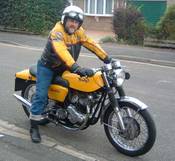Quoted Text
Steve, that's a very interesting account, and I appreciate its depth, but I don't entirely agree with you that the 9th SS is typical of the SS overall. It certainly is only partially accurate when describing the original four SS divisions.
Those four grew out of four regiments: LS, Germania, Deutschland and Der Führer. They were combined as the SS-Verfügungs Division for the invasion of France, then gradually upgraded to PG divisions, then later full Panzer divisions (the difference being the number of tanks allotted).
The LAH (also called LSSAH) and the other "four core" Waffen SS divisions (Wiking, Das Reich and Totenkopf) had been strengthened to the status of Panzer divisions by the campaign around Kharkov in 1943. According to George Stein's The Waffen SS: Hitler's Elite Guard at War, 1939–1945 cited here, the division already had a FlaK unit and a StuG battery.
The SS, like the rest of the Wehrmacht, liked to form new divisions rather than totally refitting existing ones. This meant the new units were often understrength and under-equipped. Therefore extrapolating one unit's OOB to another's is risky IMO.
Bill,
You are absolutely correct about the history of LAH.
However the question was specifically about the timescale 1943-44, after the bloodletting at Kursk, the robbing of some of LAH top soldiers (not just "personalities" such as Witt, Meyer, Wunsche, Bremer and Mohnke (not a particularly savoury person)), but also many junior officers and NCO's. The LAH in Normandy was a pale reflection of its former self; during it's time in France it was completely rebuilt (again).
I admit I did forget the Flak Abteilung, which had SDkfz7s pulling the 88mm guns and the other versions with 37mm; and having consulted "Steel Inferno" by Michael Reynolds, it seems LAH did have a Stug Abteilung of 45 Stugs in 3 companies. It also had a Werfer Abteilung of 3 batteries (towing vehicle probably Sdkfz10). But in the main as far as the vehicles are concerned, I wasn't too far out. Reynolds gives 1SS AA a company with 16 Pumas - I'm not totally convinced, as this is a very rare vehicle but I won't argue. He does state that the first two companies had VWs rather than the SDkfz250 halftracks they should have had.
I did say that my 9SS history had a vehicle by vehicle breakdown, it even incudes the field kitchens and bread ovens - this is seldom seen in other unit histories, it's the "missing link" of military history if you like. 9SS & 10SS are interesting units to the historian precisely because they were the last units, apart from HJ, set up and equipped in full before the kit started to run out. They are almost textbook 1944 Gliederung Panzer Divisions, because they were set up and trained in the West, in comparative peaceful conditions. By comparison, "Das Reich", the former "Verfugungsdivision", had a similar organisation to 9SS, in that it had Stugs forming the 7 & 8th companies of the Panzerregiment; and this was a unit with a history as long and as "illustrious" if that is the correct word as LAH. 17SS "Gotz von Berlichingen" was more representative of the late war divisions - it was short of officers and NCO's, and very short of equipment (much of it was of French origin). Despite this it performed creditably, if not spectacularly well.
























